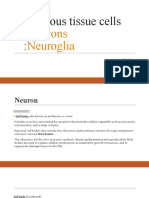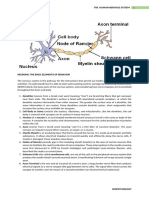Protein Provide Building Materials For The Cell and Facilitate Various Chemical Reactions.
Uploaded by
Loren SanapoProtein Provide Building Materials For The Cell and Facilitate Various Chemical Reactions.
Uploaded by
Loren SanapoINTRODUCTION NERVOUS SYSTEM CONSISTS OF 2 KINDS OF CELLS 1.
Neurons - Nerve Cells cells that receives information and transmit it to other cells. 2. Glia- perform a number of tasks other than conducting messages; their functions are difficult to summarize. STRUCTURES OF AN ANIMAL CELL The edge of the cell is a MEMBRANE OR PLASMA MEMBRANE structure that separates the inside of the cell from the outside environment. All animal cells have a nucleus except for the red blood cells NUCLEUS -structure that contains the chromosomes. MITOCHONDRION is the structure that performs metabolic activities. Providing the energy that the cell requires for all its other activities. ENDOPLASMIC RETICULUM- network of thin tubes that transport newly synthesized proteins to other locations. GLIA OR NEUROGLIA- the other major components of the nervous system, do not transmit information over long distances as neurons do. The functions of glia Star-shaped astrocytes wrap around the presynaptic terminals of several axons, presumably a functionally related group. Astrocytes remove waste material, particularly waste created when neurons die. MICROGLIA- very small cells. It also remove waste materials, fungi, viruses and other microorganisms. In effect they function like part of the immune system. OLIGODENDROCYTES produce myelin sheaths that insulate certain vertebrate axons in the CNS SCHWANN CELLS -Produce myelin sheaths that insulate certain vertebrate axons in the PNS. RADIAL GLIA type of astrocyte, guide the migration of neurons and the growth of their axons and dendrites during embryonic development. Microglia proliferate I areas of brain damage and remove toxic materials.
RIBOSOMES are the sites at which the cell synthesizes new protein molecules. (Protein provide building materials for the cell and facilitate various chemical reactions.)
You might also like
- Microscopic Anatomy of the Nervous SystemNo ratings yetMicroscopic Anatomy of the Nervous System32 pages
- (PSY 304) Chapter 1 - Nerve Cells and Nerve ImpulsesNo ratings yet(PSY 304) Chapter 1 - Nerve Cells and Nerve Impulses9 pages
- Chapter 1 Nerve Cells and Nerve Impulses 2No ratings yetChapter 1 Nerve Cells and Nerve Impulses 219 pages
- Physiology U-3 Excitable Nervous TissueNo ratings yetPhysiology U-3 Excitable Nervous Tissue122 pages
- Nervous Tissue Cells::: Neurons NeurogliaNo ratings yetNervous Tissue Cells::: Neurons Neuroglia7 pages
- 1 Hist Sept 13 ReadingNerve - Tissue2020No ratings yet1 Hist Sept 13 ReadingNerve - Tissue202026 pages
- CELL Are The Small Living Units of An OrganismNo ratings yetCELL Are The Small Living Units of An Organism6 pages
- Neurons (Brain Cells) : The Structure of The NeuronNo ratings yetNeurons (Brain Cells) : The Structure of The Neuron2 pages
- 218880-2018-Revenue Office Tax Exemption Manual TESLite20221008-12-1h3k0fuNo ratings yet218880-2018-Revenue Office Tax Exemption Manual TESLite20221008-12-1h3k0fu71 pages
- SEC Opinion - Mr. Fernando C. Santico - 178279-1991-Mr. - Fernando - C. - Santico20210623-11-9s3w53No ratings yetSEC Opinion - Mr. Fernando C. Santico - 178279-1991-Mr. - Fernando - C. - Santico20210623-11-9s3w532 pages
- 2021 Suwa - Shipyard - Machineries - Corp.20211108 12 MkhgioNo ratings yet2021 Suwa - Shipyard - Machineries - Corp.20211108 12 Mkhgio4 pages
- For+Posting+Notice+0948 2022+ORDER+ +ERC+Case+No.+2019 081+RC+ (Consolidated+With+DO) + (HVB+SGD)No ratings yetFor+Posting+Notice+0948 2022+ORDER+ +ERC+Case+No.+2019 081+RC+ (Consolidated+With+DO) + (HVB+SGD)56 pages
- BIR Ruling No. 001-89 - Proposed Donations of The Shares of Stock - 4916-1989-Proposed - Donations - of - The - Shares - of - Stock20210505-12-LmqzzrNo ratings yetBIR Ruling No. 001-89 - Proposed Donations of The Shares of Stock - 4916-1989-Proposed - Donations - of - The - Shares - of - Stock20210505-12-Lmqzzr2 pages
- The Philippine Acetylene Co.: BIR RULING NO. 159-59No ratings yetThe Philippine Acetylene Co.: BIR RULING NO. 159-591 page
- SEC Opinion - Atty. Victor Africa - 177678-1986-Atty. - Victor - Africa20210424-12-1kjtmauNo ratings yetSEC Opinion - Atty. Victor Africa - 177678-1986-Atty. - Victor - Africa20210424-12-1kjtmau5 pages










































































